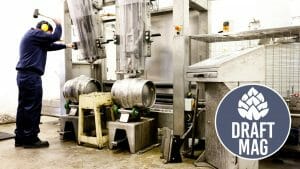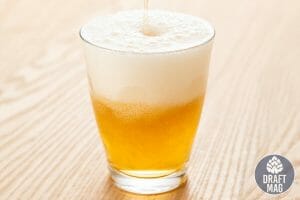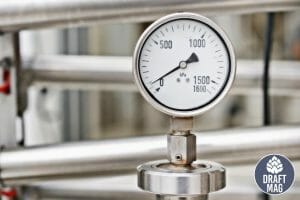Beer Color: A Comprehensive Guide To Colorful Brews
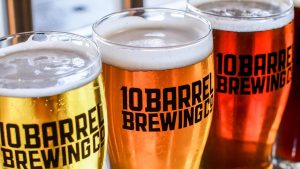 Beer color is the first thing you will notice when drinking a glass of beer.
Beer color is the first thing you will notice when drinking a glass of beer.
It’s feasible to make the perfect color combination for a particular hue by learning which ingredients and brewing procedures are responsible for the color of a beer.
You can find Color Flavor Wheels that will help you find the beer color based on the hops, malt, and yeast used. In this article, we’ll walk you through different aspects of beer coloring and the factors that determine the color of a beer.
What Color Is Beer?
The color of beer is transparent pale yellow to a dark brown – nearly black opaque tint when viewed with the naked eye. These colors can give you some clues about how it will taste.
You can expect coffee, chocolate, and darker overtones if a beer is dark because it contains roasted malts. A medium-gold beer brewed with barley or wheat may have some bready aromas, whereas a reddish beer is more likely to be malt-driven, with some fruity or nutty overtones. A light-colored beer will have more vibrant qualities, such as citrus, acidity, pepperiness, sharpness, tropical fruit flavors, and so forth.
Color is a vital aspect of our food and drink experiences, and beer is no different. The color of the beer is the first thing a potential beer drinker notices when it is poured into a clear glass. Color typically evokes subconscious expectations about the forthcoming taste experience.
What Are the Factors Affecting the Color of Beer?
The color of the beer is affected by various aspects in the chemistry of its manufacture and additives.
Let’s look into some of the factors that determine the color of a beer:
– Grains
One of the most crucial coloring components in the beer is grain. All beers are red at their most basic chemical level.
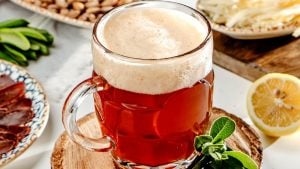 So the fact that most beers aren’t red colored beer – they are generally golden or brown – should tell you something: there’s something extremely essential going on at the molecular level that causes beer to change color.
So the fact that most beers aren’t red colored beer – they are generally golden or brown – should tell you something: there’s something extremely essential going on at the molecular level that causes beer to change color.
This is because beer is created from grain starches.
Grain is stained by a pigment known as melanin, which imparts a rust-red color to the beer and is hence the most crucial coloring factor. To change this natural hue, you will have to run a series of chemical procedures.
Dark malts may give your beer a dark color. Beers made with light malts often develop a deeper hue as the color builds up, resulting in a darker colorful brew.
– Mashing
Mashing is a brewing word for steeping ground malted barley in water. It is done by raising the temperature to a specific point or changing the temperature throughout the steeping process.
During the process, the pH of water plays an important role; the more the pH, the darker the hue.
Furthermore, the longer the mash stays in contact with the grains, the darker the brew will be. Some brewers maintain the water at the exact temperature while others alter it. After the brewing process, you may see the difference in beer color clarity and limpidity.
– Chemical Reactions
Maillard reactions and caramelization reactions are the two different types of chemical processes that modify the color of beer. Maillard reactions are chemical processes that occur when amino acids and sugars are linked together using high heat.
As a result of this heat, various flavors and fragrances will emerge. It’s also linked to a darkening of the beer color. In a nutshell, the longer the boiling period of a beer, the darker the beer.
On the other hand, caramelization entails boiling sugar till it disintegrates. Grains grown in the fields do not contain sugars. Therefore you must first heat the grain starch to convert it to sugar.
After that, brewers increase the temperature even further to break down these sugars that just started to develop. This imparts a caramel flavor to the end product. The beer flavor can range from burnt sugar to toffee. The longer the caramelization, the darker it becomes.
– Time
There will always be visible color changes in aged beers. Time is color, is a popular phrase in the brewing community. As time passes, suspended substances in beer, such as yeast and polyphenols, settle to the base of the bottle or can.
This implies that the beer will mirror less light, giving the impression of a darker beer. As a result, simply aging the beer will darken it over time. Beers grow less bitter as the isomerized alpha acids that cause bitterness break down over time, allowing the malts to take center stage.
– pH Level
A very acidic combination causes beer to appear paler than usual. Even the chemical composition of water can have an impact. Meanwhile, as pH levels fall, the color of the beer is likely to lighten slightly.
This is primarily caused by the loss of color by some molecules in fermenting beer. The pH levels in beer color follow the natural law here. Hence the denser the pH, the darker the color of the beer.
– Boiling Time
Boiling is the second most essential component that affects the color of the beer. Boiling duration varies depending on the brand of beer and the preparation. Extract brewers recommend boiling for only an hour. The protein in malt extract coagulates in 10 minutes.
The isomerization of the hop alpha acid necessitates a longer boiling time for hops. The longer the beer is allowed to boil, the darker it becomes. Conversely, the shorter the boiling time, the lighter the beer color becomes. The isomerization process takes one hour and aids in bitterness.
The wort gravity is another essential aspect in determining the color of a beer. The color of the beer will be affected by boiling the wort to a specified temperature.
How To Determine the Color of Beer
You can determine the color of beer using these methods:
– SRM Scale
The Standard Reference Method (SRM) scale helps determine the color of beer. In this method, the light of a specific wavelength passes through one centimeter of beer. After that, the amount of light that the beer absorbs is calculated.
These shades range from light straw with an SRM value of 2 to black with an SRM value of 40.
- SRM ranging from 2 to 5 are classified as gold or pale. These are light lagers.
- Results on the scale ranging from 7 to 15 are amber.
- Copper brown is defined as a measurement result between 16 and 25.
- In addition, 25 to 39 shades are dark brown or black.
- However, if it is over 40, it will be classified as black or opaque. Imperial stout is an excellent example of a 40.
Porters and stouts have diverse shades of brown, red, and dark brown in general, and they range from 20 to 40 on the SRM scale.
– Lovibond Scale
You can determine the color of a beer by comparing it to a color chart. The Lovibond scale, invented by Joseph Williams Lovibond, is the oldest and most widely used technique for determining beer color.
Brewers frequently use this beer color scale to show wort color while utilizing the SRM scale to select the final product.
The color sensation of each individual is a significant disadvantage of the Lovibond approach. Lovibond himself compared wort samples using glass plates colored in the traditional beer hues.
The technologies used today are far more computerized and precise. Some online converters convert degrees Lovibond (degL) to EBC or SRM scale and vice versa.
You may also use the equations below:
degL = SRM + 0.6) / 1.35
SRM = (degL * 1.35) – 0.6
– EBC Scale
The EBC color scale, created by the European Brewing Convention and the Institute of Brewing, is a widely accepted method for grading the color of beers, caramel solutions, malts, and other similar-colored liquids. Here the light colored beers have a lower numeric value similar to the SRM scale.
You can also quickly convert one value to another by using the equations below:
SRM = EBC × 0.508
EBC = SRM × 1.97
It ranges from 2 to 27 SMR units, with lagers and yellower pale worts at the low end and the amber of dark worts, caramels, and beers at the high end.
– Objective Measuring
Whether you are doing it in a lab or at home, determining the color of the beer isn’t challenging.
If you are interested in the exact hue of your beer, try these steps:
- Collect the beer into a glass or a cup with a diameter of at least one to two inches (five centimeters).
- Using a paper towel or a clean white cloth, put the glass of beer in front of a neutral or white background.
- Then compare the beer sample to a beer darkness scale available online. This way, you will notice the precise match right away.
While using this method, you will only get reliable results in natural light. The beer will be brighter if you use other artificial light sources, for example, a flashlight.
In this situation, you may use the Lovibond scale to determine the color of your beer. Also, the subjectivity of your eyes will influence the outcome, as not everyone perceives color in the same way.
If you wish to specify the numerical color value on the SRM color chart, you will need cuvettes, a spectrophotometer, and a computer with the appropriate software.
What Are the Colors of Different Beer Styles?
The colors of different beer styles depend on their SRM value. Blondie beers, citrus combos, pilsners, and sour beers all have light SRM colors, ranging from 2 to 11.
You will find red and orange colored beer like amber ales, IPA beer color ranging from orange to amber, and other lagers in the 11 to 20 range. However, after 20, you’ll find dark beers.
|
Beer Type |
SRM value |
| Pilsner | 2 to 7 |
| Belgian strong ale | 4 to 7 |
| Vienna lager | 7 to 14 |
| American pale ale | 6 to 14 |
| Imperial pale ale | 5 to 11 |
| Amber ale | 11 to 18 |
| English brown ale | 12 to 22 |
| Porter | 20 to 40 |
| Imperial stout | 50 to 80 |
Endnote
Beer coloring is a hot topic for beer enthusiasts and craft brewers alike and generates a lot of debate, but in the end, it is all about the experience.
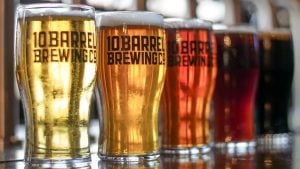 A brilliant golden beer may conjure up images of summer days spent in beer gardens, while a reddish-black beer with a thick brown head may bring back memories of malty roasted tastes and sitting in front of a raging fireplace.
A brilliant golden beer may conjure up images of summer days spent in beer gardens, while a reddish-black beer with a thick brown head may bring back memories of malty roasted tastes and sitting in front of a raging fireplace.
Here are the important points we have learned in this article:
- Beer comes in various colors, varying from pale to dark black to nearly colorless.
- Brewers commonly use the EBC or EBC scales to determine the exact shade of their brew.
- The flavor and color of a beer can be predicted by its type.
- The higher the SRM value, the darker the hue of the beer.
There are, however, variations in style depending on the brand and recipe. As a result, beer color is all about probabilities and expectations. To truly comprehend how the beer tastes, you must do more than admire its color – you must open it and drink it!


